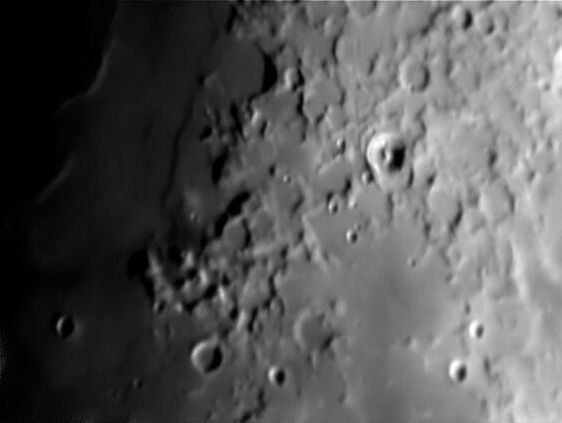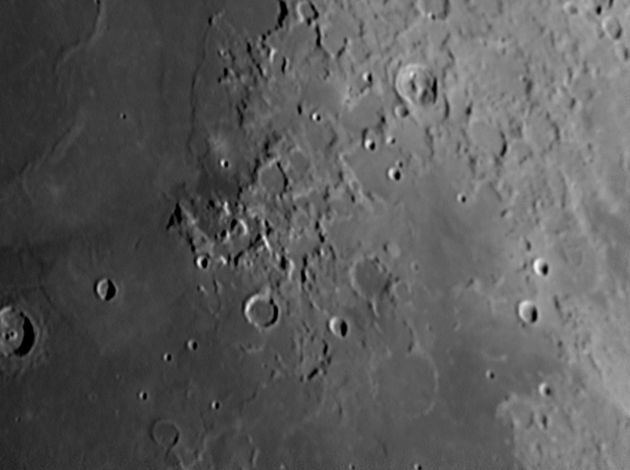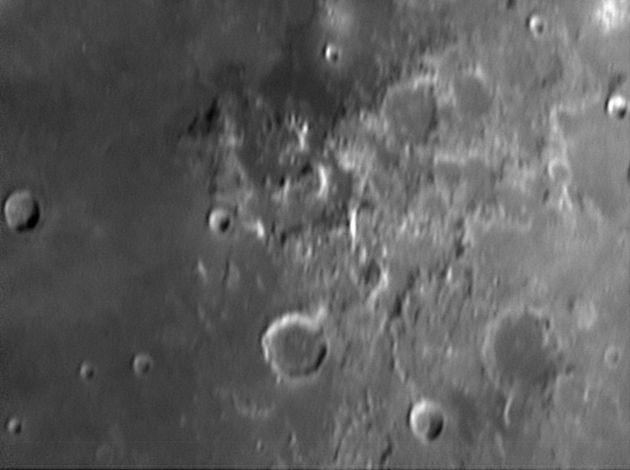

Move your mouse over the image to see just where.
Full details of the mission can be found at the web site of the
Lunar and Planetary Institute

Apollo 17 was the last manned landing on the Moon in the Apollo programme and the last for at least 30 years.
The lunar module landed at 19:54:57 UT on 11th December 1972 in the Taurus Littrow Highlands, at lunar coordinates 20.19°N 30.77°E.
Taurus Littrow is on the boarders of the Serenitatis basin and appeared to have many the elements that the geologists wanted to study;
Cinder cones yielded what was likely to be young, volcanic material, whilst steep-sided valleys with boulders at the bottom presented what
was possibly older, mountain material. This endeavour was undoubtedly aided by the presence on the surface of the first
fully qualified geologist in the Apollo programme. All previous landers had been manned by professional pilots who had had
some training in geology; this mission had a professional geologist, Harrison Schmitt, who was trained as a pilot.
The lunar rover enabled them to cover 30 Km and collect 110.5 Kg of samples during 22 hours exploration out of the
75 hours they spent on the surface.
As with all the other lunar modules, once its job of returning the astronauts to the command module was done, it was jettisoned on a trajectory
that caused it to crash to the surface. This one crashed at 19.96°N 30.5°E, about 15 Km from the Apollo 17 landing site.
The scale markers are 100 km north and east.
Date and Time: 041217 1713 UT (Day 6.4)
Telescope: LX200 at Prime Focus.

Although this picture was taken only 19 lunar hours later than the one above, the lighting is very
much better and yielded a clearer picture. This was aided slightly by the libration which moved the
terminator a little further to the west compared with the earlier picture. I am amazed at how many of the
craters in this area have their own names rather than taking that of a nearby crater with an added letter;
for example the tiny crater, Ching-Te just on the other side of the mountain from the landing
site; I have been unable to find a name for this mountain but I'm sure it must have one.
The scale markers are about 100 Km north and east.
Date and Time: 050215 1956 UT (Day 7.2)
Telescope: LX200 at Prime Focus.

And finally a closer picture showing the landing site in a little more detail. The picture
was taken when the Moon was 8.4 days old, about a day later than the picture above.
Date and Time: 041219 1842 UT (Day 8.4)
The scale markers are about 50 Km north and east.
Telescope: LX200 with X2 lens.
(Only in exceptional seeing conditions
in this light-polluted area of eastern England can I get clearer pictures than this at this magnification.)
On a personal note, I find it sad that, after all the effort of sending six missions to the Moon, the programme and its accumulated
expertise has been allowed to evaporate. When it is decided to send men back to the Moon again, the whole
process will have to be largely re-invented. Having said that, I for one am hugely grateful to the American People who, alone, funded
these expeditions for doing so and for making all the results freely available to everyone. Scientists are still working on the
samples brought back. Home Back to Moon